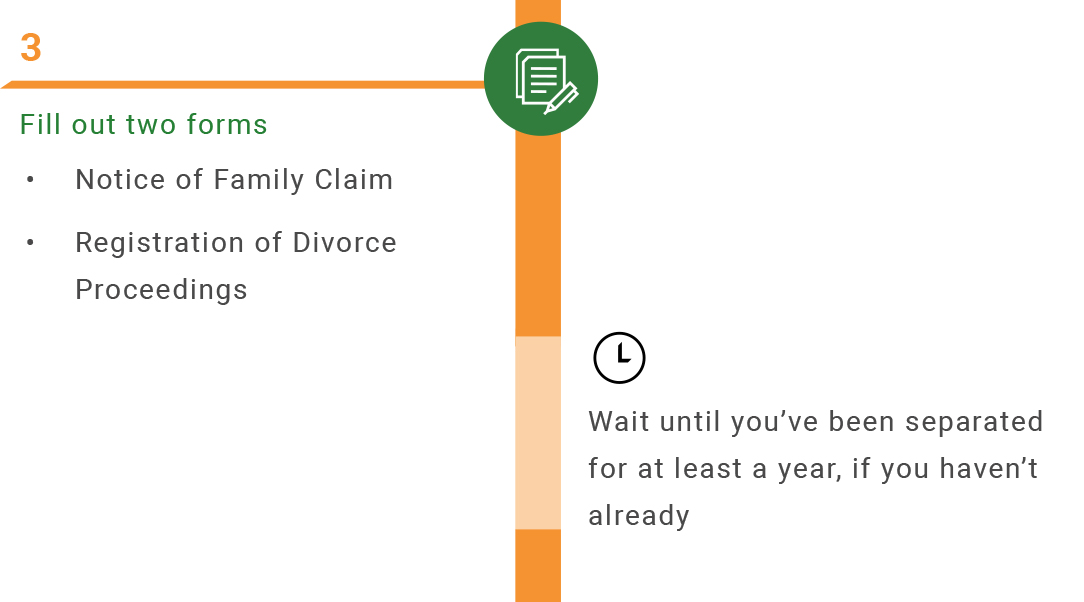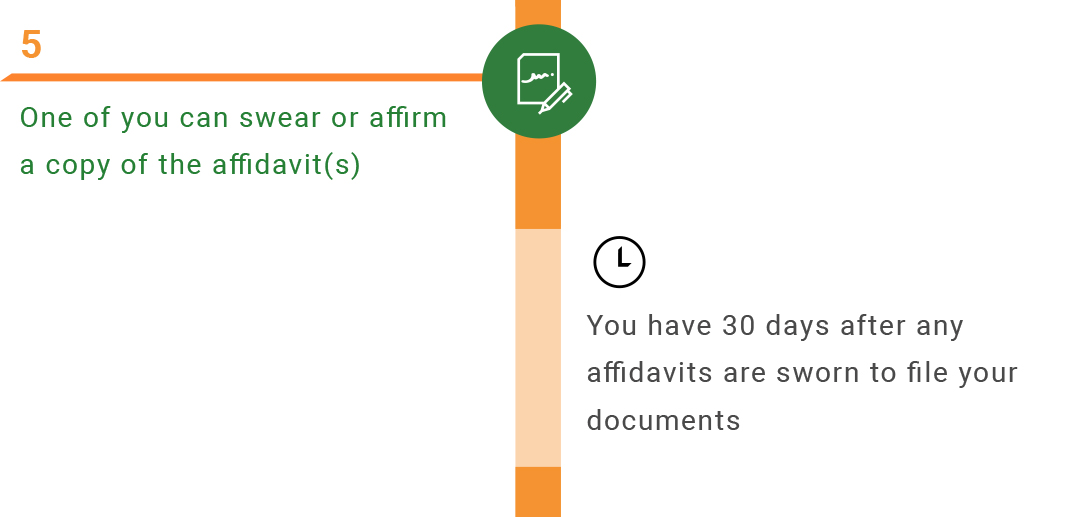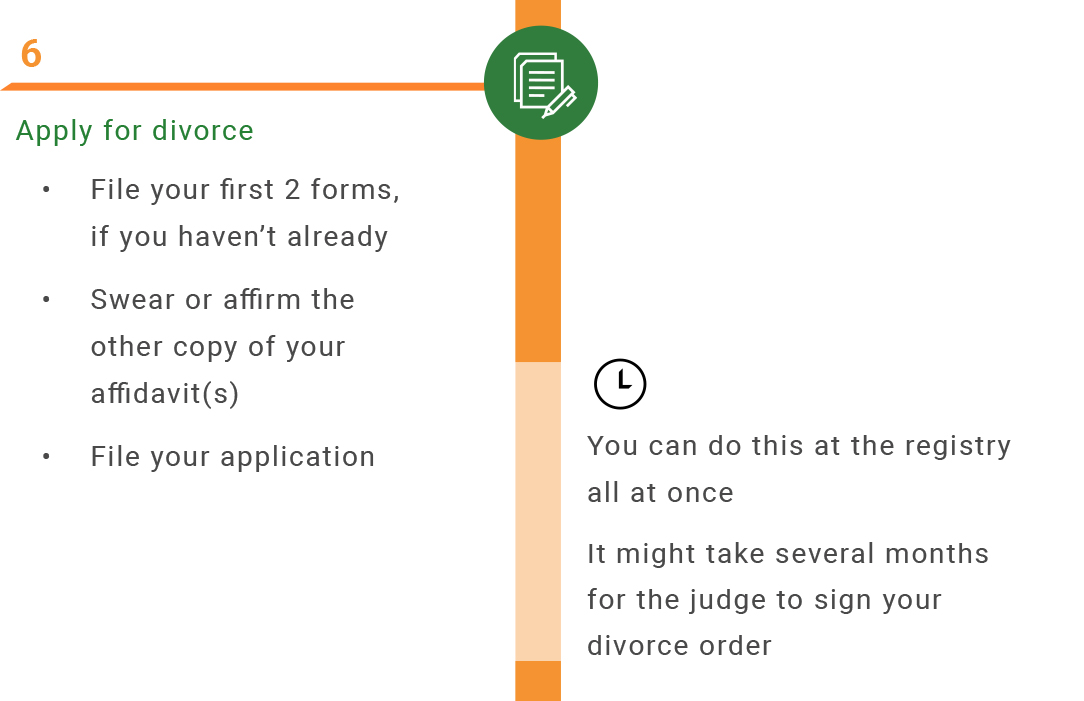Introduction
Who this guide is for
This guide is for spouses who want to make a joint application for a simple uncontested divorce. This means you both agree on all your family law issues and only need to apply for a divorce order. You both need to sign all the documents in this process.
Use this guide if all the following statements are true:
- You want to file for divorce in BC.
- You and the other person agree about getting a divorce.
- You already have written agreements or orders for:
- parenting,
- child support,
- spousal support, and
- how to divide your property and debt.
- One of you has lived in BC for at least one year right before you start your divorce and is living in BC when you start the divorce proceeding.
- You've been separated for at least one year.
- You're not applying for divorce on the grounds of cruelty or adultery.
What if this guide isn't for you?
How long does it take to do your own divorce?
It's possible to do your divorce in a few months once you've settled all your family law issues. But there are wait times, and it might take longer if:
- your Supreme Court registry is busy,
- one person lives outside your court registry's jurisdiction, or
- if your application is rejected and needs to be resubmitted.
How much does it cost to do your own divorce?
You'll pay a few different court fees when you apply for a divorce:
- The fee to open a family law case with the Supreme Court:
- $30 — if you've already filed a separation agreement with the Court (it will have a court file number on it that you can use in your divorce application), or
- $200 — if you don't have a filed separation agreement and the Notice of Joint Family Claim is the first court document you're filing.
- $10 to file the Registration of Divorce Proceedings form.
- $80 to make the final application.
You might also have to pay for:
- Making photocopies of your documents.
- Having your affidavits sworn. It costs around $40 to have this done at the court registry. Places offering notary services might charge different prices.
- Getting a certified copy of your original marriage certificate or registration of marriage. In BC, this costs $27.
- Having your marriage certificate translated into English and getting an Affidavit of Translation.
- Ordering a Certificate of Divorce (Form F56), if you want one. This costs $40.
Get legal help
Talk to a lawyer
Before you begin your own divorce, meet with a family lawyer to find out about your rights and responsibilities. You or your spouse might have a right to spousal or child support, or to property, pensions, or other assets that you don't know about. Or you might have to pay spousal or child support or take responsibility for certain debts. The court won't usually order a divorce unless your family law issues (particularly child support) have been settled in a written agreement or court order.
To find a lawyer, call the Lawyer Referral Service.
Dividing property and debts
Dividing property and debts can be complicated. If you have property and debt together, get legal advice.
You only have two years from the date of your divorce to claim (start a court action for) spousal support or your share of property and debt. See Dividing property and debts after you separate for more information.
If you can't afford a lawyer
If you can't afford a lawyer, you can get legal help in other ways, including:
Staff at Justice Access Centres in Abbotsford, Nanaimo, Surrey, Victoria, and Vancouver can also answer your questions and help you fill out forms. Call someone who can help or find your nearest office.
If you want to use a mediator, see Making mediation happen in a family law case in Supreme Court.
Work through this guide at your own pace. There's no need to rush.
- you or your spouse lives in BC,
- you agree about getting a divorce and all the family law issues relevant to your situation, and
- your marriage certificate (or registration of marriage) is in English.
You'll need a Basic BCeID account to access the Online Divorce Assistant. See how to set up a basic BCeID account if you need help.
Gather your documents
You'll need
- your original marriage certificate,
- money to pay a translator to translate your marriage certificate into English, if needed,
- a copy of your separation agreement or court order(s), and
- your change of name certificate, if needed.
Your marriage certificate
To get a divorce, you need your original marriage certificate or a certified true copy of your marriage registration. The court won't accept the certificate you got from the place where you got married.
If you were married and need to get a marriage certificate:
- In BC, see Marriage Certificates to find out what BC marriage certificates look like, and how to order one from the BC government's Vital Statistics Agency.
- In another province or territory, contact the office equivalent to Vital Statistics in that province or territory.
- In another country, contact the office responsible for marriage records in the country where you were married.
There's usually a fee to have your original marriage certificate or a certified copy sent to you. In BC, it costs $27 to order your marriage certificate from the Vital Statistics Agency.
Your separation agreement or court order
You need your separation agreement or court order(s) to show what you've agreed to or what the court has already ordered about parenting, child support, spousal support, and other family law issues.
If you haven't already filed your agreement with the Supreme Court, do that now to open a family law case. For more information, see Step 2: File your agreement, if you have one.
To make a separation agreement, contact a family justice counsellor, mediator, or family lawyer for help. You can also use our step-by-step guide Write your own separation agreement.
For more help, see Making an agreement after you separate and Who can help you reach an agreement?
Your change of name certificate, if needed
You don't need to apply for a legal name change to use the name you had before you were married. After you separate, you can use either your name from before you were married or your spouse's name without legally changing it.
If you did have a legal name change and want to change it back or change your name to something new, you can do that in your divorce application. To do this, you need your change of name certificate from the Vital Statistics Agency.
Quick links
Whatever you feel as you work through this guide is normal and okay.
File your agreement, if you have one
If you have an agreement about parenting arrangements, contact with a child, child support, and/or spousal support and you haven't yet filed it with the court, do that now. Filing your agreement is a simple process. (See File Your Agreement in Supreme Court.) You also save money if you do it before you file anything else.
Your family law agreement might cover various family law topics, such as parenting, support, and property and debt division. As long as it includes parenting, support, or both, it can be filed in court.
You'll need
- a copy of your signed parenting and/or support agreement
- a blank Requisition (Form 17.1), and
- $30 to pay the filing fee.
How to file your agreement
Make a copy of your signed parenting and/or support agreement.
Fill out the Requisition (Form F17.1) to ask the court to file the agreement.
On the first page, fill in your name as Claimant #1 and the other person's name as Claimant #2. Check the box to confirm that there are no orders made or currently being sought.
Take the Requisition, a copy of your agreement, and the $30 filing fee to the registry.
You can file your agreement at the Supreme Court registry where an existing case between you and your spouse is filed. If no court action has been started, you can file at the registry closest to where you live.
The staff at the family registry counter checks that the agreement is complete. Then they take your payment and stamp the agreement with the court seal. If there's already an existing family law case, they put the agreement into your court file.
If no court action has been started, the registry will stamp a court file number on your agreement when you file it. You now have an open family law case. Put the same court file number on the rest of the forms you're preparing so the registry knows that you already have an open file. This way you won't have to pay the $200 fee to open a case when you file your Notice of Joint Family Claim.
It can help to talk about your feelings with a supportive friend or a group of people in the same situation.
Fill out two forms
You'll need
- a blank Notice of Joint Family Claim (Form F1)
- a blank Registration of Divorce Proceedings form,
- a copy of your separation agreement or court orders, for reference, and
- your original marriage certificate, for reference.
This step is divided into three parts. The third part is optional and depends on your situation.
Part 1: Notice of Joint Family Claim (Form F1)
The Notice of Joint Family Claim gives the court details about:
- you and the other person,
- your marriage and separation, and
- what you're asking the court for.
The form has a main section to fill out, plus optional schedules for different types of orders. Because you've already settled your family law issues in a separation agreement or court order(s), you only need to fill in the first three and the last one or two sections of the form.
Part 2: Registration of Divorce Proceedings form
Fill out the Registration of Divorce Proceedings form online. In Section 1, type the date you'll go to the registry to file the application for divorce. This might be different from the date you fill out the form.
Once you've filled out the form, print it out (this generates a barcode used to process the form). Take this form with your Notice of Joint Family Claim for filing at the court registry.
This form goes to a central registry in Ottawa. The registry in Ottawa will check their records to make sure you have no other divorce proceedings pending in Canada. The judge can't grant you a divorce order until they send written clearance back to your registry. This can take 4 to 6 weeks.
Part 3: Go to Step 4 or file the first two forms
You need to fill out a few more forms for your divorce application. You can either file your first two forms now, or you can wait and file them together with the next set of documents. It depends on your situation.
Quick links
You're making good progress. Take a break if you need to.
Fill out the next forms
You'll need
- A blank Affidavit — Desk Order Divorce (Form F38)
- A blank Child Support Affidavit (Form F37), if you have dependent children
- A blank Requisition (Form F35)
- A blank Certificate of Pleadings (Form F36)
- A blank draft Final Order (Form F52)
- Your separation agreement or court orders
- Your photo identification (ID)
- Someone to swear or affirm your affidavits (a lawyer, notary, or other commissioner)
Fill out your affidavit(s)
You won't need to go to trial and give evidence to a judge. Instead, you write your evidence in affidavits. An affidavit is a form that you fill out. You then swear or affirm in front of a Commissioner for Taking Affidavits that the information in the affidavit is true.
You need to fill out:
Affidavit — Desk Order Divorce (Form F38)
This sets out all the facts of your marriage and separation, and gives information about parenting time if you have children.
Child Support Affidavit (Form F37)
This gives information about your children and child support, if you and the other person have children. Attach a copy of your separation agreement or court orders to this form as exhibits. See the tip box above, under Fill out your affidavit(s), for more information about exhibits.
You and your spouse can prepare the Affidavit — Desk Order Divorce together, or you can print two copies and each swear one. You'll learn more about this in the next step.
When you're adding your names on the first page of either form, choose Claimant 1 and Claimant 2 from the drop-down boxes. If you were Claimant 1 on your Notice of Joint Family Claim, you're Claimant 1 here as well.
Fill out three more forms
Next, you need to fill out three more forms:
Requisition (Form 35)
This tells the court that you want a divorce (and a name change, if you want one). It also tells the court what documents you're providing to support your application. On the first page of the form, under Required, type or write:
"A Final Order, without a hearing, in the form attached."
Certificate of Pleadings (Form F36)
The registry staff sign this form to show the judge that your documents have been checked and are complete and correct.
Draft Final Order (Form F52)
This sets out the orders the court makes. You fill in all the details, and the judge signs it. This will be your divorce order once the judge has signed it.
Both of you must sign the Requisition and the Final Order. Only the person who reviews your documents at the registry will sign the certificate.
Quick links
You might feel anxious about using the court forms, but it's just a matter of filling in certain facts. Take them one question at a time.
Swear or affirm the affidavit(s)
There are strict rules for when you can swear or affirm your Affidavit — Desk Order Divorce (Form 38). You can only do it after:
- you and the other person have been separated for one year, and
- your Notice of Joint Family Claim has been filed at the court registry. You can file the Notice and then swear your affidavit during the same visit to the registry.
Instructions for the person swearing their affidavit in advance
You can have the affidavit(s) sworn by a:
- lawyer,
- notary public, or
- other commissioner for taking affidavits.
If you want to use a lawyer or a notary public (for a fee), make sure they can swear or affirm the document for you. You might need to make an appointment. Tell them that the documents are an Affidavit — Desk Order Divorce and, if applicable, a Child Support Affidavit and exhibits for your divorce. Tell the person that you don't need legal advice.
You can also find commissioners in both Supreme Court and Provincial Court registries. See Who can swear an affidavit?
When you go to have your affidavit(s) sworn, the person swearing the documents checks your photo identification. They ask if you've read the documents, and if you swear (or affirm) that the contents are true to the best of your knowledge and belief. If you answer yes, you sign the documents, and the person swearing the documents then signs the affidavit and stamps it (which consists of their name and contact information).
Quick links
Getting enough sleep can help you work through stressful times.
Apply for a divorce
You'll need
- your completed forms and supporting documents,
- $10 to file your Registration of Divorce Proceedings, if it's not already filed,
- $80 to file your application for divorce,
- money to have your Affidavit — Desk Order Divorce sworn, if you need to (it costs around $40 to have this done at the registry).
Prepare your application
Now that you've completed all the documents, you need to apply for your divorce.
Make one copy of your completed forms:
- Notice of Joint Family Claim (Form F1), if it's not already filed
- Registration of Divorce Proceedings, if it's not already filed, with:
- your original marriage certificate, and
- your English translation and Affidavit of Translation, if you needed them
- Requisition (Form F35)
- Draft Final Order (Form F52)
- Certificate of Pleadings (Form F36)
- Child Support Affidavit (Form F37), if you completed one, with your separation agreement or court orders attached as exhibits
- Both your and the other person's Affidavit — Desk Order Divorce (Form F38), or one of them if you are filing one affidavit jointly
File your application at the registry
Take the original set and the copy of your documents to the registry. The registry staff reviews your documents.
They file your Notice of Joint Family Claim and Registration of Divorce Proceedings first, if you haven't filed them already. Filing the Registration of Divorce Proceedings costs $10. If you filed your separation agreement already, filing the Notice won't cost anything. If you didn't file the Notice first, filing it costs $200.
The registry staff will take your oath to swear or affirm your Affidavit — Desk Order Divorce (there's a $40 fee for this).
If the rest of your documents are ready to file, they take your payment for your divorce application. As of May 2022, it costs $80. They stamp the original and the copy, and give the copy back to you.
Ask the registry staff when your divorce order is likely to be ready for pick up.
Pick up your signed divorce order
The registry won't notify you when the order has been signed. Contact them after four weeks to see if it's ready.
Once you've picked it up, keep a copy of it in a safe place. Give or mail a copy to the other person.
When will you be divorced?
The divorce becomes effective 31 days after the judge signed the order. For example, if the judge signed your divorce order on September 15, your divorce will be final on October 16.
These 31 days are the appeal period. The other person can file a last-minute appeal during this time to stop the divorce, but this is rare.
It's normal to feel tense or emotional at this point. Take a break if you need to.
Final steps
Certificate of Divorce
You can order a Certificate of Divorce (Form F56) from the registry any time after the divorce is final.
This step is optional. Your divorce is still legal if you don't have a Certificate of Divorce. If you want to remarry, your divorce order is enough.
Some countries require a certificate as legal proof of divorce. In Canada, you can use either the certificate or your divorce order. A certificate shows proof of your divorce without revealing all the details in your order.
Copy and keep safe
Copy and keep these important documents safe:
- your signed divorce order,
- your separation agreement or court orders, and
- your Certificate of Divorce, if you order one.
You've now gone through all the steps required to get a joint uncontested divorce in Supreme Court. Thank you for using our step-by-step guide.
People react differently to things. Whatever you feel now is okay.







